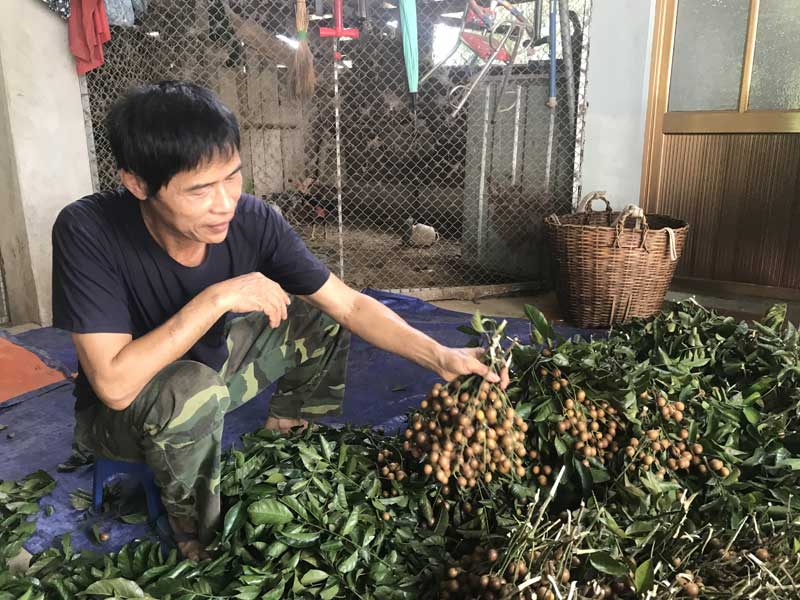
(HBO) - The middle of June is the time when people in Dong Giang hamlet, Mong Hoa commune (Hoa Binh city) harvest clausena lansium. The harvesting time is just over one month. Every day, cars and motorbikes of businessmen flock in and out in Dong Giang. Along Highway 6 in Mong Hoa commune there are a lot of sellers and buyers.

Dong Giang clausena lansium.
With
more than 60 clausena lansium, up to this time, Mr. Bui Van Hung's family in
Dong Giang hamlet, Mong Hoa commune (Hoa Binh city) has harvested over one ton
of fruit with an income of nearly 30 million VND.
In
Dong Giang, there are clausena lansium trees which are hundreds of years old.
The local people do not know when they have been, either. In the neighborhood,
every household has at least fifteen trees, there are households growing as
many as 50 to 60 trees, and even many households have more than 100 trees. For
a long time, clausena lansium in Dong Giang has become a specialty of tourists
near and far. Indeed, the bunches of dark brown clausena lansium with small and
beautiful fruits are not only delicious in the summer that are popular with
many people, but they are also the valuable medicinal herbs being handed down
for a long time.
This
summer, due to the prolonged strong sunlight with less rain, the quality and
output decreased compared to the previous crop, clausena lansium in Dong Giang
continues to bring the economic benefits to the households. 40 -50 kilos have
been harvested from the small trees, the average trees have given from 100-150
kg. The selling price is from 20,000-25,000 VND a kilo.
The
head of Dong Giang hamlet, Mr. Nguyen Ngoc Tuan added that along with the rice
cultivation, the economic development of forests, clausena lansium has been
identified as a key crop in the village. Thereby, the per capita income
currently reaches 36 million VND a year. The rate of the poor households has
decreased to 3%. In the long term, we want the appropriate authorities to
conduct surveys and researches to build the brand for Dong Giang, making this
special tree into OCOP product so that people can continue promoting the
movement of improving the mixed gardens and expanding the areas to improve the
living standards.
Hoa Binh province is undergoing a dynamic transformation amid Vietnam’s national digital transition. Building on Poliburo’s Resolution No. 57-NQ/TW on breakthroughs in science, technology, innovation, and national digital transformation, the province has rolled out a wide range of practical action plans. A standout initiative is the "Digital Literacy for All” movement, an effort to ensure that no one is left behind in the digital era.
Hoa Binh province is undergoing a dynamic transformation in the wake of the national digital transformation movement. Building on Resolution No. 57-NQ/TW of the Politburo on breakthroughs in science, technology, innovation, and national digital transformation, the province has implemented a wide range of practical action plans. A standout initiative is the "Digital Literacy for All” movement ambitious effort to ensure that no one is left behind in the digital age.
With a spirit of unity and proactive problem-solving, the Party Committee, the government and the people of Dong Lai Commune (Tan Lac District) have made great strides in implementing the resolutions of the 24th Party Congress of the commune for the 2020 - 2025 term. Focusing on leadership and practical actions, the commune has brought the Party’s resolutions into daily life, creating strong impacts and pushing the local development forward.
Amid the nationwide push for digital transformation, young people in Hoa Binh Province are stepping up as dynamic pioneers, applying technology to enhance Youth Union operations and expand the reach of youth-led initiatives. Through creativity and adaptability, Youth Union organizations at all levels have introduced a series of practical solutions, contributing to modern governance and community development.
In recent years, An Nghia commune, located in Lac Son district, has stepped up administrative reform, focusing on improving the quality and efficiency of its single-window service unit for receiving and processing administrative procedures. These improvements have helped create favourable conditions for local residents and organisations to handle administrative procedures, contributing to the commune’s broader socio-economic development.
The Prime Minister-approved master plan to develop the multi-use value of forests ecosystems through 2030, with a vision to 2050, aims to improve the management and sustainable use of forest resources, create jobs, increase incomes, and improve the living standards of ethnic minorities, people in mountainous and remote areas, forest workers and those living near forests.



